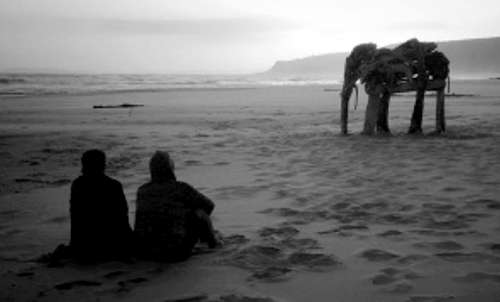Understanding Land Art
Site_Specific International Land Art Biennale 2013
Seeing our world through new eyes
by Tia Egglestone, March 2013
I live on an avocado and pumpkin farm in the Crags, just outside of Plettenberg Bay, that hosts the spoils of the scenic and serene Nature Valley's beach as my backyard, my stomping grounds, my hiking and rock climbing grounds, my fishing, diving and surfing grounds. I visit the beach most days after work with my partner and my puppy to relish in gratitude for where we find ourselves fortunate enough to live.
One afternoon, we came across a structure made of driftwood. The pieces came together like pieces of the earth's puzzle. It towered over our heads balancing upright in the sand and held together by nothing more than its' natural connectivity and a few pieces of wire. It was only from a distance, as the last rays of sunshine beamed against the driftwood, did we see the silhouette of walking legs, a swinging trunk and a watchful eye: a solitude elephant standing in the flow of the sprawling seascape, the velvety beachscape and the rugged mountainscape. As many inspirational thoughts and manifestations from within that the driftwood elephant brought to us, it brought just as many questions: What is this? How was it done? Who did it? And, what does it mean?
- Driftwood Elephant, Nature's Valley Beach (January 2013) by Simon Max Bannister. Photo: Simon Max Bannister.
This was my first encounter with Land Art, but I didn't know it with that name until weeks later. I received a call from my friend asking if her artist friend, Simon, could take pictures of our property to use for a new 'Land Art' proposal. Walking around the property and the dam, Simon imparted insights onto us about his work, his play, and a process greater than paint on canvas.
The cycle of Land Art begins with a naturalistic backdrop and evolves from the environmental intricacies within. It is a demonstration of the mutual connection between the visions and the hands of the artist and the mediums provided by Mother Nature. But, rather than imposing art onto a landscape, the landscape imposes an awareness to its' sights, sounds and reasons through the art. In the end, as with most things, the natural processes of change return the art to the landscape - giving back to the earth what she gave to us.
Simon went on to tell us about a local up-coming project he is working on in order to develop consciousness about the culture of Land Art. In conjunction with nature conservationist, Galeo Saintz, the duo will host a two-day walking experience on August 13 - 14 with the prospects to engage in the exploration of Land Art. As part of the Site_Specific event, the walk from Nature's Valley to Plettenberg Bay provides 12 participants with the opportunity to understand the philosophy of and absorb Land Art as an unfolding story through the practical experience that draws attention to the creative expressions in nature.
As Simon described the nature of his work, I was reminded of the driftwood elephant found on Nature's Valley beach some weeks earlier. I started to tell Simon about the driftwood elephant and its' many complexities. A smile spread across Simon's face as he listened to me describe the elephant and my reaction to it. His smile never faded as he said 'I worked on that in January'.
And, just as the elephant elicited many questions, about symbolism and origin, for me as the viewer; Simon, as the artist, had just as many questions for me about his own creation: How did it break apart? Could you see the eye of the elephant? Did anyone adapt it? And what do you think?

